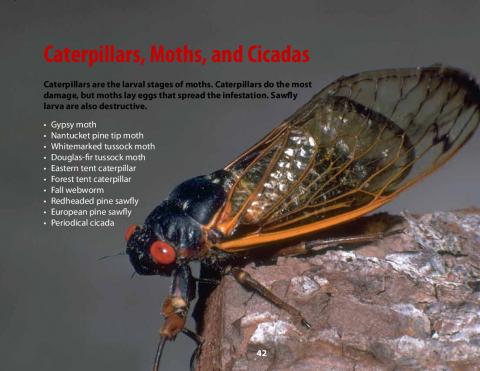42
Caterpillars, Moths, and Cicadas
Caterpillars are the larval stages of moths. Caterpillars do the most
damage, but moths lay eggs that spread the infestation. Sawfly
larva are also destructive.
• Gypsymoth
• Nantucket pinetipmoth
• Whitemarked tussockmoth
• Douglas-fir tussockmoth
• Eastern tentcaterpillar
• Forest tentcaterpillar
• Fall webworm
• Redheaded pinesawfly
• European pinesawfly
• Periodical cicada
42
43
Gypsy moth
The gypsy moth is one of the most important
insect pests in the Northeast. It causes widespread
defoliation, often of the entire tree. Gypsy
moth larvae are sometimes confused with tent
caterpillars or fall webworms because they are all
“hairy”, but each has distinct color patterns to help
you identify them.
Older larvae are brownish-gray, with tufts of hair
on each segment and a double row of five pairs of
blue spots, followed by six pairs of red spots, on
the back. Mature larvae are from 1½” to 2½” long.
Adult male moths are dark brown, with wavy dark
bands across the forewings. Female moths are
white and cannot fly. Females deposit egg masses
on sheltered spaces like under rocks and on tree
trunks, houses, picnic tables, campers, mobile
homes, and cars.
Gypsy moth
larvae.
USDA APHIS PPQ
Archive, USDA APHIS
PPQ, Bugwood.org.
Gypsy moth
larva and
damage.
USDA APHIS PPQ
Archive, USDA APHIS
PPQ, Bugwood.org.
44
Gypsy moth, continued
Female gypsy moth.
USDA APHIS PPQ Archive, USDA APHIS PPQ, Bugwood.org.
A female gypsy moth with a male
(look closely)!
USDA APHIS PPQ Archive, USDA APHIS PPQ, Bugwood.org.
45
Nantucket pine tip moth
This bud and shoot borer occurs throughout the
East and South, injuring the growing shoots of
young pines. There are 2 to 5 generations per year.
Early larvae feed on needles and surfaces of new
growth, while later larvae move to shoot tips and
begin boring into buds or stem tissues.
Young larvae are cream colored with black heads.
Mature larvae are light brown to orange and
about 2⁄5” long. The head, body, and appendages of
the moth are covered with gray scales, while the
forewings are covered with patches of brick-red
and copper-colored scales.
USDA Forest Service Archive, USDA Forest Service, Bugwood.org.
Pennsylvania Department of Conservation and Natural Resources—
Forestry Archive, Bugwood.org.
46
Whitemarked tussock moth
The white marked tussock moth occasionally
occurs in epidemic numbers and heavily defoliates
several species of hardwood, primarily oaks. It is
not considered a serious forest pest, but it causes
considerable damage to shade and ornamental
trees.
The larvae are 1” to 1½” long, with a bright red
head , a yellowish body, a pair of upright pencil
tufts of black hairs on the prothorax, and four
white to yellowish brush-like tufts of hairs on the
back toward the head. The adult male moth is gray
brown, with darker wavy bands and a white spot.
The female is wingless and whitish gray.
Winged male.
Andrew J. Boone, South Carolina Forestry
Commission, Bugwood.org.
47
Whitemarked tussock moth, continued
David Cappaert, Michigan State University, Bugwood.org. Wingless female laying her eggs.
John L. Foltz, University of Florida, Bugwood.org.
48
Douglas-fir tussock moth
This caterpillar is an important defoliator of true
firs and Douglas-fir in western North America. The
first indication of attack appears in late spring.
Defoliation occurs in the tops of trees and outer
branches, then in the lower crown and innermost
area of branches later. By August, upper crowns may
be completely bare.
The adult male moth is brown to black with feathery
antennae and a wingspan of about one inch. The
female is wingless but has a large abdomen. Young
larvae are about 1⁄8”–1⁄4” long and at maturity can be
up to 1¼” long. They are dark brown to buff-colored
with long dark tufts of hair.
A male Douglas-fir tussock moth.
David McComb, USDA Forest Service, Bugwood.org.
49
Douglas-fir tussock moth, continued
William M. Ciesla, Forest Health Management
International, Bugwood.org. Female Douglas-fir tussock
moth laying eggs.
Jerald E. Dewey, USDA Forest Service,
Bugwood.org.
50
Eastern tent caterpillar
The eastern tent caterpillar is primarily an
aesthetic problem and has little effect on the host
trees. Species of the genus Prunus are preferred,
with black cherry being the primary host.
Full-grown larvae are between 2” to 2½” in length.
Caterpillars have black heads, with long, light
brown body hairs. The back has a light stripe,
bordered on each side with yellowish-brown and
black wavy lines. (Compare this solid stripe to the
dots down the back of the forest tent caterpillar.)
The sides are marked with blue and black spots.
Moths have a wingspread of about 2” to 2½” and
are yellowish-brown, with two narrow, light lines
across the front wings. The larvae construct a
white web or tent in the crotch of a small branch.
They consume the entire leaf with the exception of
the midrib.
Tim Tigner, Virginia Department of Forestry, Bugwood.org.
51
Eastern tent caterpillar, continued
Tim Tigner, Virginia Department of Forestry,
Bugwood.org.Pennsylvania Department of Conservation
and Natural Resources—Forestry Archive,
Bugwood.org.
This resource originates from http://www.ca.uky.edu/ag…. Click on this link to download from the source. If the original link doesn´t work, click on the image in the box on the right and download a copy.

